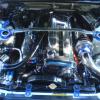Rb26 Compression Ratio
Announcements
-
Similar Content
-
Latest Posts
-
HFM BM57 has a "bad" knee point, IIRC. It's not the same thing as the later R chassis MC.
-
The ATTESSA is functionally identical to R34; there were a bunch of JDM models that continued ATTESSA including Fuga/Q70, Skyline/Q50, Cima etc as an option. All with Auto only and I think mostly for snow regions. AFAIK there were no AWD VR30DDTT sold in Australia - it is on my to do list to check regs for racing a LHD car in Targa/ATR/AASA/CAMS events because if I can get the auto to work it would be interesting to run a 4wd car The Ecuteck TCM tuning is the same model as their ECU tuning, they already have it for R35 and Dose's favourite, BMW. You buy "points" to allow your computer to be tuned, buy either a bluetooth (phone app) or bluetooth+USB+Key (phone and PC) dongle, and pay for a tune that will be locked to your tuner ( ). You can also access the tuning software yourself but 1. it is mega expensive and 2. these computers have a billion parameters that intersect, so how could you ever spend enough time on it to get a decent result.
-
Or, is it a case of what it is like owning an R series Skyline? NFI what the previous owner has done or fiddled with... Ha ha ha After reading through this thread, I went on a bit of a research about the Q50/Q60. Now I'm quite intrigued by them! Is the AWD in them more like a WRX where it's always AWD, or is it more like the ATTESSA in the GTRs? By the sound of this TCU tuning, this sounds like a case of someone has made some real software for it, and you just need the right piece of hardware, and then you license that specific vehicle/TCU. Or is this a case of the software will be really expensive so only a few tuners have it, and you still have to pay a license per vehicle?
-
By popular demand.. it was a coil. Got my hands on 1 new OEM coil, replaced with the one that made the less noise difference when I unplugged it while the car was running and started the car up. No stutter and the engine light was gone. I guess I’ll buy the other 5 they have lol
-
By joshuaho96 · Posted
No, code 21 is very straightforward. It can only be the things described in that diagnostic flow. In fact it has no way of knowing that the spark plug resistance is out of spec.
-






Recommended Posts
Create an account or sign in to comment
You need to be a member in order to leave a comment
Create an account
Sign up for a new account in our community. It's easy!
Register a new accountSign in
Already have an account? Sign in here.
Sign In Now